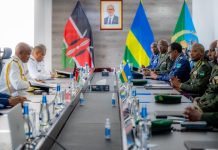Africa-Press – Rwanda. The government projects to provide scholarships to 16,768 students admitted to the University of Rwanda (UR), Rwanda Polytechnic (RP), Rwanda Institute for Conservation Agriculture (RICA) during the 2025/2026 academic year, following the introduction of a double intake system, according to Higher Education Council (HEC).
HEC indicated that this increase follows the government’s decision to eliminate the one-year gap that students previously spent waiting to join higher learning institutions after completing high school. The reform aims to reduce redundancy and keep students actively engaged in their academic journey.
As a result, the number of students benefiting from government scholarships has risen from 11,789 in 2024/2025 (of whom 8,618 were in Science, Technology, Engineering, and Mathematics (STEM) programmes, representing 73.1 per cent, and 3,171 in non-STEM programmes, representing 26.9 per cent) to 16,768 in 2025/2026 — including 11,135 STEM students (66.7 per cent) and 5,633 non-STEM students (33.3 per cent), according to data The New Times received from HEC.
The overall figure includes 12,229 students at UR; 4,472 at RP; and 67 at RICA.
“This had a budget implication of 39.2 per cent increase. Both STEM and Non-STEM students will be financed,” HEC estimated.
Students welcome support
One of the new beneficiaries, Samuel Cyusa, who completed secondary studies in Mathematics-Chemistry-Biology (MCB) combination in the 2024/2025 academic year, expressed gratitude for the government support.
Cyusa was admitted to UR’s College of Science and Technology to study Chemistry.
“It’s something of great value because many of us come from families that cannot afford university tuition,” he said, noting that without the government loan, continuing his education would have been challenging
“Receiving the loan is an opportunity to pursue studies—otherwise, limited means would make it impossible.”
Similarly, Divine Umuhoza, admitted to UR’s Busogo Campus, who completed secondary school in MCB combination in 2024/2025, received a government scholarship to study Crop Production at UR’s College of Agriculture, Forestry and Food Science (CAFF).
“In general, the loan is very helpful as it supports us in our studies. The monthly Rwf40,000 living allowance adds to its benefits,” she said, indicating that the amount she is supposed to pay back after completing studies is Rwf12 million.
Both Cyusa and Umuhoza have been attending induction week at their respective colleges and are set to officially begin university studies on Monday, November 10.
They confirmed that they applied for and were granted government study loans.
Speaking to the New Times about the double intake, HEC Director General Edward Kadozi explained that the reform was introduced to address the problem of students staying idle for a year between completing high school and starting university.
“The double intake came as a solution from the Ministry of Education and the government to address the challenge of students staying home for a year after finishing high school. This situation caused several issues, including students losing motivation or even dropping out,” he said.
He added that the Ministry of Education, HEC, UR, RP, and the Ministry of Finance and Economic Planning (MINECOFIN) jointly developed the plan to ensure its feasibility and sustainability.
“The decision was taken after extensive discussions with all stakeholders. We knew the numbers would increase, and we worked together to find practical solutions. Once this system is in place, we will no longer have students waiting at home for a year,” Kadozi observed.
Budget implications
During the 2025/2026 national budget hearings in May 2025, over Rwf17.7 billion had initially been allocated for student loans — covering both continuing and new students, including Rwandans studying abroad.
When asked how the double intake would affect the student loan budget, Kadozi confirmed that the funding will increase to reflect the expanded intake.
“The budget will increase, and we already identified this. We are discussing with the Ministry to align with the number. But in principle, all the institutions, the Ministry of Education, the Ministry of Finance, the two higher learning institutions, they aligned on availing this budget,” he said.
Admission criteria, priorities
Admission to academic programs at UR and RP is based on the minimum entry requirements established by each college. Due to limited space, only a select number of applicants are admitted, which does not imply that others failed.
To ensure merit-based admissions, cut-off marks are determined for each program based on available capacity and applicants’ performance in their subject combinations. Each academic program sets a specific cut-off aggregate depending on its absorption capacity.
When fewer applicants are admitted than expected, high-performing students who could not secure places in competitive programs may receive provisional admission to other eligible programs, subject to confirmation through registration.
Weighted aggregate scores are used for objectivity and fairness, and additional criteria apply for specific programs — such as clinical exams and interviews for Medicine and Dentistry, and fitness tests for Physical Education and Sports.
In cases where many high-performing candidates compete for limited spaces, grades in relevant subjects are considered. This approach ensures that admissions remain competitive and merit-based.
Once the list of admitted students (both STEM and non-STEM) is finalised, it is shared with HEC. Students may then apply for government scholarships, which are assessed and granted by HEC. Successful applicants sign loan contracts with the Development Bank of Rwanda (BRD), which manages student loans on behalf of the government.
However, not all admitted students receive government scholarships, as some choose to self-sponsor, HEC indicated.
Kadozi indicated that the government’s student loan programme primarily supports students in STEM and health-related fields, in line with national priorities and academic performance standards.
This focus, he said,supports initiatives such as the “4×4 Program”, through which the Ministry of Health aims to quadruple the health workforce by 2028 – to meet the threshold of one healthcare worker per 1,000 population as recommended by the World Health Organization. Currently, Rwanda has one healthcare worker per 1,000 population, as per data from the Ministry of Health.
“We want to address the question of workforce in health sector, and that’s why we provided such opportunities,” Kadozi said.
For More News And Analysis About Rwanda Follow Africa-Press






